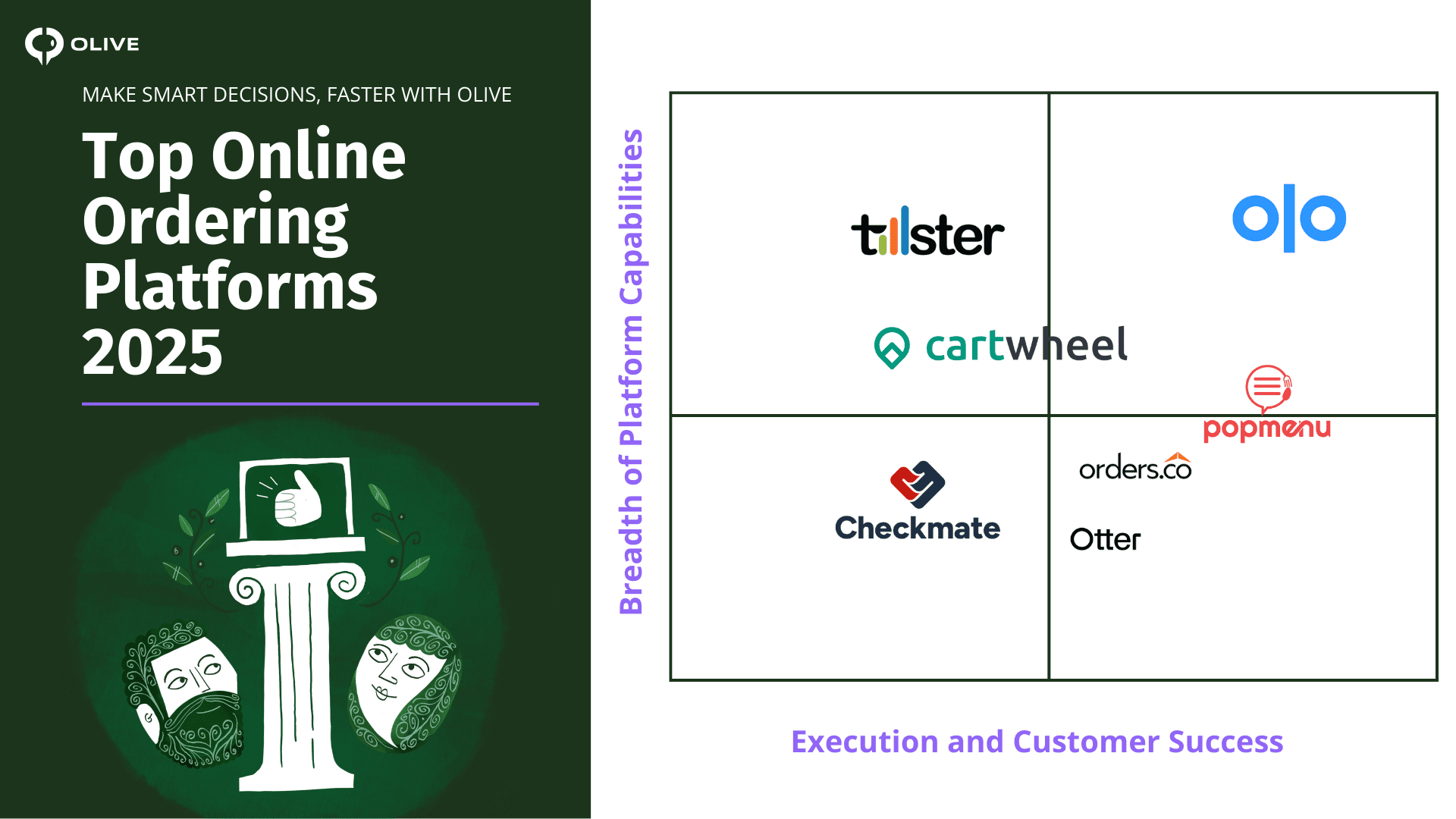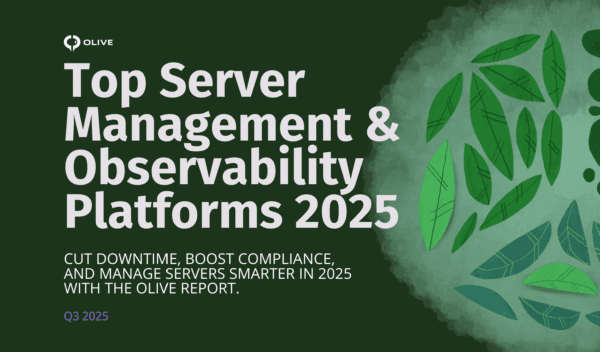Top Online Ordering Systems in 2025: What Restaurants Need to Know
The restaurant industry has transformed dramatically, and nowhere is that more obvious than in how restaurants manage online ordering. As off-premises dining continues to dominate, online ordering platforms have evolved into mission-critical tools for driving revenue, operational efficiency, customer satisfaction, and brand differentiation.
In this report, powered by OliveAI research, we present a deeper analysis of the top online ordering systems for restaurants in 2025, evaluated based on market adoption, feature depth, platform flexibility, and innovation. Whether you’re a single-location operator, a multi-unit franchise, or a virtual brand powerhouse, these platforms offer solutions to meet your evolving business needs.
What to look for in an Online Ordering System
When assessing Online Ordering you can focus on four core criteria:
- Scalability: Ability to support growing and multi-unit operations
- Integration: Compatibility with POS systems, loyalty programs, third-party delivery marketplaces
- Customer Engagement: Features to drive loyalty, upselling, and direct marketing
- Operational Efficiency: Tools to consolidate and optimize delivery, pickup, and kitchen performance
Top Online Ordering Platforms for 2025
1. Olo – Best for: Enterprise Brands and Chains
Olo remains the enterprise benchmark for digital ordering infrastructure. Its modular platform supports direct ordering, Dispatch (native delivery management), Rails (third-party integration), and Network (marketplace connections). Major brands like Shake Shack and Wingstop rely on Olo to scale frictionless digital experiences across thousands of locations.
Key Features:
- Native app and web ordering frameworks
- Deep POS integration across leading providers
- Dispatch for managing delivery fulfillment
- Order throttling, smart menu customization
- High-availability APIs for custom dev work
Strengths:
- Scalability for national and global brands
- Enterprise-grade reliability and security
- Flexibility to integrate with loyalty, CRM, and third-party tools
Considerations:
- High implementation and subscription costs may deter SMB operators
- Long onboarding timelines
2. Orders.co – Best for: Independent Restaurants and Emerging Brands
Orders.co provides a streamlined, affordable online ordering platform for independent operators looking to manage third-party delivery channels and drive direct orders. Their easy-to-use dashboard consolidates Uber Eats, DoorDash, Grubhub, and direct channels into a unified interface, helping smaller brands gain enterprise-like efficiency.
Key Features:
- Aggregated third-party marketplace management
- Direct online ordering site creation
- POS integrations (Toast, Square, Clover, more)
- Automated menu sync
Strengths:
- Fast deployment
- Low cost of entry
- Useful for growing direct order volumes
Considerations:
- Limited flexibility for highly customized enterprise workflows
- Basic marketing and CRM functionality compared to larger competitors
3. Popmenu – Best for: Restaurants Seeking All-in-One Marketing and Ordering
Popmenu offers a hybrid platform blending digital ordering with website hosting, marketing automation, and customer engagement. It is designed for operators who want to drive repeat business and own the guest relationship end-to-end. Popmenu has steadily grown adoption among independent operators and mid-sized brands.
Key Features:
- Dynamic menu pages optimized for SEO
- Direct online ordering
- Automated remarketing campaigns
- Integrated loyalty programs
Strengths:
- Unified customer data across ordering and marketing
- Strong focus on guest retention
- Built-in upselling and promotional tools
Considerations:
- May offer more functionality than needed for operators purely seeking ordering capabilities
- Design and customization may be somewhat templated
4. Checkmate – Best for: Restaurants Managing Multiple Delivery Platforms
Checkmate is a middleware solution that aggregates orders from third-party delivery marketplaces and syncs them directly to a restaurant’s POS. Designed to eliminate “tablet hell,” Checkmate streamlines operations for multi-unit operators heavily reliant on third-party delivery.
Key Features:
- Order aggregation across Uber Eats, Grubhub, DoorDash, etc.
- POS syncing with major systems (Toast, Revel, Micros, more)
- Menu syncing and auto-updates across platforms
Strengths:
- Reduces operational complexity
- Saves labor by automating third-party order management
Considerations:
- No direct online ordering marketplace for first-party sales
- Dependency on external marketplaces remains
5. Otter – Best for: Optimizing Delivery and Takeout Performance
Otter focuses on analytics-driven delivery optimization. Beyond consolidating orders, Otter offers reporting on channel profitability, menu performance, and fulfillment efficiency. It is ideal for restaurant groups seeking to maximize delivery channel margins.
Key Features:
- Order aggregation
- Menu performance analytics
- Delivery times and performance reporting
- Recommendations for pricing and menu optimization
Strengths:
- Strong reporting and insights
- Actionable recommendations to improve margins
Considerations:
- Not a full direct ordering replacement
- Heavy focus on third-party performance management
6. Tillster – Best for: Multi-Channel Digital Ordering Solutions
Tillster enables multi-touchpoint digital ordering (web, mobile, kiosk) and loyalty integration. Focused on QSR and fast-casual enterprises, Tillster is tailored to brands seeking consistent, branded experiences across all guest interfaces.
Key Features:
- Mobile app and web ordering development
- Self-service kiosk systems
- Loyalty program integration
- White-label delivery services
Strengths:
- Flexible white-label digital experience
- Large brand expertise
Considerations:
- Higher cost structure
- Longer time-to-market for complex custom projects
7. Cartwheel – Best for: Managing In-House and Hybrid Delivery Models
Cartwheel empowers restaurants to manage a mix of in-house drivers and third-party delivery providers. It is increasingly important for operators trying to protect margins and control guest experience while offering delivery flexibility.
Key Features:
- Hybrid delivery dispatch management
- Driver tracking and routing
- Branded customer tracking pages
Strengths:
- Gives operators control over delivery logistics
- Reduces reliance on high-fee third-party couriers
Considerations:
- Requires operational infrastructure (e.g., managing in-house drivers)
- May add complexity for smaller operators without logistics experience
Final Thoughts: Choosing the Right Online Ordering Platform
Online ordering platforms are now essential infrastructure. Selecting the right one can lead to material gains in:
- Revenue growth
- Operational efficiency
- Customer loyalty
- Delivery profitability
Restaurants should conduct a careful needs analysis around:
- Volume expectations (single location vs enterprise)
- Channel management needs (native ordering vs third-party aggregation)
- Integration requirements (POS, loyalty, marketing)
- Brand control (white-label solutions vs marketplaces)
About Olive
At Olive, we empower restaurant and hospitality businesses to find and implement the right technology solutions faster, smarter, and with unbiased insights.
Heading to Food On Demand Conference 2025? Meet our team at the Bellagio to see how OliveAI can help you streamline your tech sourcing, compare vendors, and find your next winning platform.
Ready to find the perfect online ordering solution? Visit Olive and discover a better way to build your restaurant tech stack.






